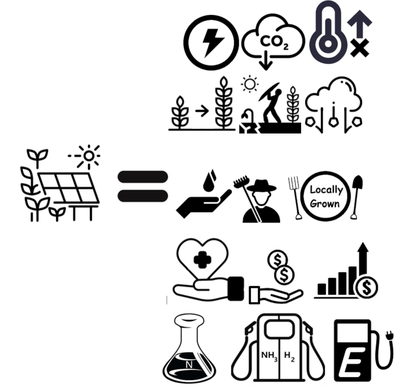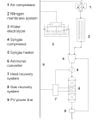
As Alberta increases conventional solar power generation, land-use conflicts with agriculture increase. A solution that enables low-carbon electricity generation and continued (in some cases, increased) agricultural output is the co-locating of solar photovoltaics (PV) and agriculture: agrivoltaics. This review analyzes policies that impact the growth of agrivoltaics in Alberta. Solar PV-based electricity generation is governed by three regulations based on system capacity. In addition, agrivoltaics falls under various legislations, frameworks, and guidelines for land utilization. These include the Land Use Framework, Alberta Land Stewardship Act, Municipal Government Act, Special Areas Disposition, Bill 22, and other policies, which are reviewed in the agrivoltaics context. Several policies are recommended to support the rapid deployment of agrivoltaics. Openly accessible agrivoltaics research will help optimize agrivoltaic systems for the region, and can be coupled with public education to galvanize social acceptability of large-scale PV deployment. Clearly defining and categorizing agrivoltaics technology, developing agrivoltaics standards, making agrivoltaics technology-friendly regulations and frameworks, and developing programs and policies to incentivize agrivoltaics deployment over conventional PV will all accelerate the technology’s deployment. Through these measures, Alberta can achieve conservation and sustainability in the food and energy sectors while simultaneously addressing their renewable energy and climate-related goals.
See also[edit | edit source]

- Coal with Carbon Capture and Sequestration is not as Land Use Efficient as Solar Photovoltaic Technology for Climate Neutral Electricity Production
- Dual use of land for PV farms and agriculture literature review
- sheep
- Israeli white plastic reflectors
- A Farmer's Guide to Going Solar (NREL)
- German guidelines: https://www.ise.fraunhofer.de/content/dam/ise/en/documents/publications/studies/APV-Guideline.pdf
- 2021 review
- Miskin, C.K., Li, Y., Perna, A., Ellis, R.G., Grubbs, E.K., Bermel, P. and Agrawal, R., 2019. Sustainable co-production of food and solar power to relax land-use constraints. Nature Sustainability, 2(10), pp.972-980.
- Retrofitting solar parks for agrivoltaics
- Shading PV
- Alexis' talk at American Solar Grazing Association2021
In the News[edit source]
- Agrivoltaics: solar energy + better crops Climate and Nature
- Why solar power and farmers’ fields could be the perfect combination TVO
- Solar farms and sheep show the makings of a clean energy classic duo Business Renewables
- Agrivoltaics charge up St. Albert-area farms St Albert Gazette
- Sheep, solar and crops. How some Alberta farms are creating ideal growing conditions Western Wheel
- Sheep, solar and crops. How some Alberta farms create ideal growing conditions Voxpopuli
- Protein bars from recycled plastic bottles? An indoor farm on wheels? Western prof gets innovative with green tech Toronto Star
- 加拿大环保狂人回收塑料瓶制成蛋白棒 还有可移动室内农场!? Lahoo
- Solar
- Papers
- Agrivoltaics
- Solar power
- Solar energy
- Photovoltaics
- Sustainable development
- Agriculture
- SDG02 Zero hunger
- SDG07 Affordable and clean energy
- SDG08 Decent work and economic growth
- SDG09 Industry innovation and infrastructure
- SDG12 Responsible consumption and production
- Canada
- Energy policy
- Farming
- Energy
- Land use
- FAST Completed




































